
(Update: REI and LL Bean have brought out new versions of their tents; see below for initial comments.)
In the tent world, the coolest and cutest are the solo tents. Small, light, with all of the features of the big boys, they inspire thoughts of long trails or fast, light overnights. But how many people actually go backpacking solo? For two people, one 2-person tent is lighter and more compact than 2 solo tents.
But in our world (mainly the woods and hills of the northeast), we use solo tents far more often when we’re going out in twos or threes than when we’re going solo. That may seem odd, but think about the immediate advantages of solo tents.
First, you can separate yourself from the snorer of the group (or the others can separate themselves from YOU). Second, nobody’s equipment gets mixed together, avoiding that disconcerting “where the heck is my headlamp???” syndrome as you pack for the next trip. Third, simply, is privacy. Want to take a nap, read a book, work on writing an article (yeah, it sometimes happens)? You can disappear into your solo tent, and nobody bothers you. Or, think about mosquito season in the lean-to shelters so common on the Appalachian Trail, Long Trail and other popular campsites here in the northeast; if there aren’t too many people using the space, a small tent (without the fly) can often be set up right inside the shelter to protect you from the little biters while you sleep.
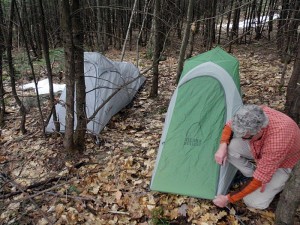
But, a solo tent really shines when you leave trails behind, and go bushwhacking in the backcountry in search of that undiscovered overlook or hidden trout stream.
Trail camping is easy; most have established campsites. There’s usually plenty of space and big 2- and 3-person tents go up easy. But finding space in the backcountry isn’t always that easy. Trees, roots, rocks, bogs, puddles, and uneven ground all make it hard to find a spot where a 2- or 3- man tent can be pitched easily AND give comfortable sleeping spots for more than one person. But, take a little solo tent, and you can pretty much put it up anywhere that there’s room for your sleeping bag. We often find spots where the center of the tent is wedged between trees…who cares? There’s room for our bodies, and room at the front for our gear. Life is good, and the stress of finding a campsite is dramatically reduced. It opens up the world for us: we look at a map, find a hill with a couple of streams or ponds around, grab our solo tents and a fishing rod, and off we go!
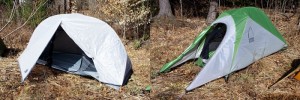
In the good old days, solo tents were limited to mostly unpalatable choices (anyone else remember the infamous “tube tents”?). But, as with the rest of the backpacking world, new materials and designs have created a plethora of high-quality options, often at surprisingly reasonable prices.
From a design standpoint, there are really two major choices.First, freestanding or not? Second, front entry or side entry? There are advantages and disadvantages to each–which is “right” is up to your needs. Freestanding tents have the advantage of being easy to pitch in all conditions (especially on rock or snow or inside a shelter); non-freestanding tents offer lighter weight (fewer poles), and less bulk.
Front entry allows for maximum flexibility in placement; you really CAN stick it between two trees and just slide into it. Also, front entry tents are generally lighter and pack up a little smaller. However, getting in and out requires more gymnastics than a side entry. Usually, front entries require backing in (with some wag around the campfire going “beep, beep, beep” while you do). Also, the vestibule on a front entry tent tends to be small, and every time you get in and out you have to move your stuff out of the way. The nature of front entry design causes another problem, as well; when it’s raining, the front door slope of the tent allows some rain to drip in. You need to get in and out quickly, and pull anything like your sleeping bag back into the tent to avoid getting it wet. Side entry tents have the advantage of ease of entry and better vestibule storage space, but most have a significantly bigger footprint when fully pitched with the rainfly. And you obviously have to have more open space to get at the long side for entry/exit than with the short side of a front entry tent. If you camp a lot in the rain, though, you may want consider side entry to avoid the water drip issue.
The choice is yours…front entry clearly will work in places that side won’t, although we honestly haven’t found too many places where we couldn’t find a spot large enough for a side entry tent.
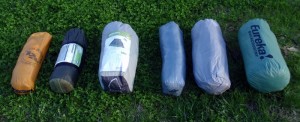
So, with no further ado, here’s what we found in our testing. All prices are MSRP; street prices WILL vary. The weights are actual measurements, not manufacturers’ posted specs, and include the tent, rainfly, poles, stakes, and stuff sacks; footprints weren’t included. Interior measurements were all taken with the tape just touching, not pushing against the fabric. Length and width (at shoulders) measurements were taken at ground level (L1, W1), and at “toe height”, about 9 inches off the ground (L2,W2). In a pinch, most of those dimensions can be expanded (we’ve sat in plenty of tents where our heads push the roof up); but, these measurements are to the point where you’d start to make contact with a surface.
Solo Tents Reviewed: Side Entry Tents:
Eureka Solo Backcountry
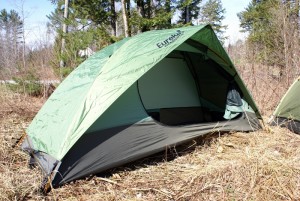 If you’re a member of the “big & tall” crowd, this is the best solo tent in our test for you. A palace by comparison with the others, it’s a wide, tall, pure rectangle. We actually stuffed two people in it; while it wasn’t comfortable, and we didn’t spend the night that way, in an emergency you actually could do it. People who have a tendency to be claustrophobic will feel comfortable in here. On one rainy trip, an editor worked inside for hours sitting comfortably in a Crazy Creek chair with his computer on his lap. Setup is about as simple as it gets; slide the poles through the mesh tubes, snap the ends into the feet, stake it out. And we DO mean “stake it out”; the rain fly has a “Flying Nun” look to it that really catches the wind. Once, we had to chase this tent when we THOUGHT it had been staked securely.
If you’re a member of the “big & tall” crowd, this is the best solo tent in our test for you. A palace by comparison with the others, it’s a wide, tall, pure rectangle. We actually stuffed two people in it; while it wasn’t comfortable, and we didn’t spend the night that way, in an emergency you actually could do it. People who have a tendency to be claustrophobic will feel comfortable in here. On one rainy trip, an editor worked inside for hours sitting comfortably in a Crazy Creek chair with his computer on his lap. Setup is about as simple as it gets; slide the poles through the mesh tubes, snap the ends into the feet, stake it out. And we DO mean “stake it out”; the rain fly has a “Flying Nun” look to it that really catches the wind. Once, we had to chase this tent when we THOUGHT it had been staked securely.
Negatives: There’s NO vestibule, period. It’s the heaviest and bulkiest of the lot, and the fly isn’t full coverage. We haven’t had it happen yet, but we believe that a wind-driven rain from the back side of the tent would let water into the tent. We wouldn’t recommend it for above treeline because of the wind issues, but if you want SPACE in a package that’s built like a tank, this is your tent.
REI Quarter Dome T1 ($199;3 lbs, 3 oz. L1-80″, L2-74.5″, W1-23″, W2-23″, H-39).
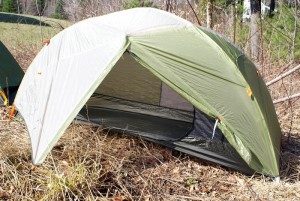 The exact opposite of the Eureka, this is the ultimate NOT “big & tall” tent. Actually, it has the slimmest and shortest space of all the tents tested. One 5’3″ female tester complained of her elbows hitting the side in her sleeping bag; another commented on feeling claustrophobic. The other negative, which went away after a little practice, was the non-intuitive setup. The poles are all attached into a single unit and require some headscratching to determine how everything connects. But, once you’ve figured it out, the tent goes up quickly and easily, and you don’t have to worry about losing a pole.
The exact opposite of the Eureka, this is the ultimate NOT “big & tall” tent. Actually, it has the slimmest and shortest space of all the tents tested. One 5’3″ female tester complained of her elbows hitting the side in her sleeping bag; another commented on feeling claustrophobic. The other negative, which went away after a little practice, was the non-intuitive setup. The poles are all attached into a single unit and require some headscratching to determine how everything connects. But, once you’ve figured it out, the tent goes up quickly and easily, and you don’t have to worry about losing a pole.
On the positive side, the REI actually had the most interior height of any of the tents we tested. If you can fit inside lying down, you’re likely to be comfortable sitting up. Vestibule space is very good, build quality is excellent, and it’s one of the lightest tents in the test (lots of mesh+small size=light weight+great ventilation). It’s also rock-solid and stable in wind, a benefit of the suspended truss pole design which was introduced to the industry with the REI “T” series tents. The larger Quarter Dome 2 is one of our favorite 2-person summer tents.
Bonus points: REI includes a compression stuff sack, allowing you to stuff it easily but make it fit in your pack better. As the second lowest priced tent in the test, it’s a rock solid bargain…as long as you don’t mind a tent that’s basically the width of your sleeping bag. We’d happily carry a few more ounces in the same design to gain some shoulder room. Update: For 2015, REI has dramatically updated the QD T1. It has an entirely new pole structure, an asymmetrical design, and a LOT more room.
EMS Velocity 1 ($239; 3 lbs, 6 oz. L1-84″,L2-79″,W1-31″,W2-30″,H-35″).
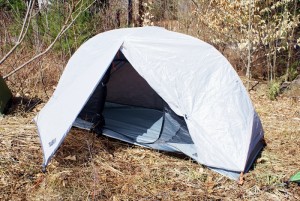 Think of the Velocity as a supersized version of the Quarter Dome T1. Similar in shape and looking virtually identical with the rainfly on, EMS has nailed the dimensions necessary to make most people feel comfortable without defeating the basic purpose of a solo tent. A 6’2″ tester was able to stretch out without hitting the ends, yet could curl up into the fetal position during the night and sit up comfortably without his head hitting the ceiling. His analysis was “STOKED!” At the other end of the spectrum, a female tester took it out for her first solo backpacking trip, and found the ease of setup fantastic at the end of a long day. One small warning on setup; the Velocity uses DAC’s “Jakes Foot” at the corners. While we love these, they can end up clipped onto the rainfly when you take the tent down; more headscratching when you try to set it up months later! The vestibule is as roomy as the interior; one of our “monster packs” easily tucks in out of the rain with room left for easy entry. About the only negative is that it has the largest footprint of any tent here; it’s not the ideal tent if you lean towards sleeping in thick spruce forests. But, short of that, if you’re willing to spend a little more for the best side-entry tent we’ve found yet, look no further!
Think of the Velocity as a supersized version of the Quarter Dome T1. Similar in shape and looking virtually identical with the rainfly on, EMS has nailed the dimensions necessary to make most people feel comfortable without defeating the basic purpose of a solo tent. A 6’2″ tester was able to stretch out without hitting the ends, yet could curl up into the fetal position during the night and sit up comfortably without his head hitting the ceiling. His analysis was “STOKED!” At the other end of the spectrum, a female tester took it out for her first solo backpacking trip, and found the ease of setup fantastic at the end of a long day. One small warning on setup; the Velocity uses DAC’s “Jakes Foot” at the corners. While we love these, they can end up clipped onto the rainfly when you take the tent down; more headscratching when you try to set it up months later! The vestibule is as roomy as the interior; one of our “monster packs” easily tucks in out of the rain with room left for easy entry. About the only negative is that it has the largest footprint of any tent here; it’s not the ideal tent if you lean towards sleeping in thick spruce forests. But, short of that, if you’re willing to spend a little more for the best side-entry tent we’ve found yet, look no further!
Solo Tents Reviewed: Front Entry Tents:
L.L. Bean Microlight Solo ($139; 3 lbs, 8 oz. L1-86″,L2-78″,W1-37″,W2-35″,H-35″).
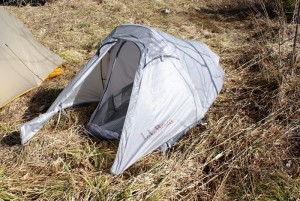 The only non-freestanding tent in the test, the Microlight Solo is a genuine bargain. For your measly few dollars, you get a LOT of space, relatively easy setup, a good vestibule, good ventilation in a small, light package. It’s far from perfect: As with any non-freestanding tent, setup requires more pegs and is more difficult on rocky ground. The drop-down door wants to get stepped on or tangle your feet. The fly and door holdbacks are irritating , at best. It comes with the cheapest and heaviest stakes in the test, and the maximum overhead height feels shorter than it really is unless you wiggle yourself to exactly the right spot. In addition, be very careful when closing the fly; the zipper loves to snag.
The only non-freestanding tent in the test, the Microlight Solo is a genuine bargain. For your measly few dollars, you get a LOT of space, relatively easy setup, a good vestibule, good ventilation in a small, light package. It’s far from perfect: As with any non-freestanding tent, setup requires more pegs and is more difficult on rocky ground. The drop-down door wants to get stepped on or tangle your feet. The fly and door holdbacks are irritating , at best. It comes with the cheapest and heaviest stakes in the test, and the maximum overhead height feels shorter than it really is unless you wiggle yourself to exactly the right spot. In addition, be very careful when closing the fly; the zipper loves to snag.
But, these are quibbles. We’ve spent multiple nights in this tent, slept well, enjoyed it…and it’s CHEAP! It’s not the best tent here, but if you’re on a budget, it’s a quality choice. Update: Bean has totally redesigned the Microlight Solo. It’s now a freestanding side-entry tent; in many ways, it’s similar to last year’s REI QD T1. The price has gone up to $169, but it definitely has some real advantages over the older model. More to come!
 Simply put, the price/performance ratio of the Vapor Light was the best of the test, period. Want to hear the negatives first? Well, if you’re much over 6 feet, it may be too short for you. And, fairly typical of Western tents, the ventilation isn’t designed for day after day of 99% humidity. And… that’s about it. Okay, we’ve got one more nitpick that we can add in…this is the first tent we’ve EVER tried where we wish the stuff sack was SMALLER; ideally, we’d stuff this into REI’s compression sack.
Simply put, the price/performance ratio of the Vapor Light was the best of the test, period. Want to hear the negatives first? Well, if you’re much over 6 feet, it may be too short for you. And, fairly typical of Western tents, the ventilation isn’t designed for day after day of 99% humidity. And… that’s about it. Okay, we’ve got one more nitpick that we can add in…this is the first tent we’ve EVER tried where we wish the stuff sack was SMALLER; ideally, we’d stuff this into REI’s compression sack.
Positives? Large tent, light weight. Entry is the easiest of any of the front entry tents; maximum overhead height is in exactly the right place, making it feel taller than it actually is. Shoulder and hip room are excellent. Setup is ridiculously easy (although the directions are mediocre, and are printed on paper; learn how to pitch it, then leave them at home so they don’t get soaked). The stakes are great. It even LOOKS good. And, one more small but very functional detail; the poles and stakes go into one integrated bag, so one less thing to lose…we’d like to see every manufacturer go to this system. Put all of this into a pot, stir well, and you’ve got the recipe for the tent we’d most likely buy with our own money.
Big Agnes Fly Creek UL 1 Person Tent
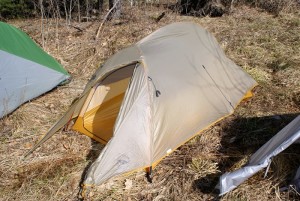 One statistic says it all- the Fly Creek UL1 is exactly one pound lighter than the second lightest tent in this test. Not one ounce, one pound. Let’s try that in percentages…how about 32% lighter than next-lightest REI, yet MUCH roomier. Big Agnes’ fanatical pursuit of lightness pays off here; you can have a real, honest-to-God human sized tent with a decent vestibule for bivvy sack weight. It’s also as tiny as it is light; we’ve carried bivvy sacks that took up more pack room. Setup is easy as well; the only quirk is a clip that connects the side of the tent to the fly so it uses a single stake; it works, but it doesn’t make for a taut, neat-looking pitch. Like the REI, the Big Agnes is a bathtub design, adding to the non-taut look. When you first put it up, it’s easy to think that you’ve done something wrong; don’t worry, you haven’t. The design works, and (once you get comfortable with the oddities), works well. It’s not perfect (nothing is); maximum headroom is well down the tent, so not entirely usable, and the “Triangle Loft” accessory, which gives you some in-tent storage, uses up some of what is left. We’d also highly recommend getting a footprint for this tent, given how thin the material is (a good idea with any tent, actually). And, of course, it’s the most expensive tent in the test; the lightest products usually are. Still, the value is there, if your hot buttons are light & small; there’s simply nothing out there like it. Plenty of room, quality materials, ridiculous weight…this is a cutting edge tent for the early adopters out there.
One statistic says it all- the Fly Creek UL1 is exactly one pound lighter than the second lightest tent in this test. Not one ounce, one pound. Let’s try that in percentages…how about 32% lighter than next-lightest REI, yet MUCH roomier. Big Agnes’ fanatical pursuit of lightness pays off here; you can have a real, honest-to-God human sized tent with a decent vestibule for bivvy sack weight. It’s also as tiny as it is light; we’ve carried bivvy sacks that took up more pack room. Setup is easy as well; the only quirk is a clip that connects the side of the tent to the fly so it uses a single stake; it works, but it doesn’t make for a taut, neat-looking pitch. Like the REI, the Big Agnes is a bathtub design, adding to the non-taut look. When you first put it up, it’s easy to think that you’ve done something wrong; don’t worry, you haven’t. The design works, and (once you get comfortable with the oddities), works well. It’s not perfect (nothing is); maximum headroom is well down the tent, so not entirely usable, and the “Triangle Loft” accessory, which gives you some in-tent storage, uses up some of what is left. We’d also highly recommend getting a footprint for this tent, given how thin the material is (a good idea with any tent, actually). And, of course, it’s the most expensive tent in the test; the lightest products usually are. Still, the value is there, if your hot buttons are light & small; there’s simply nothing out there like it. Plenty of room, quality materials, ridiculous weight…this is a cutting edge tent for the early adopters out there.
Unless you’re over 6’4″, you can find a tent in this group that’ll work for you. And, having one will mean more opportunities for you to get out, try new places, new trails, and enjoy yourself with that good friend you just can’t share a tent with. It was a long winter, you’re due for a new toy…give these a try!


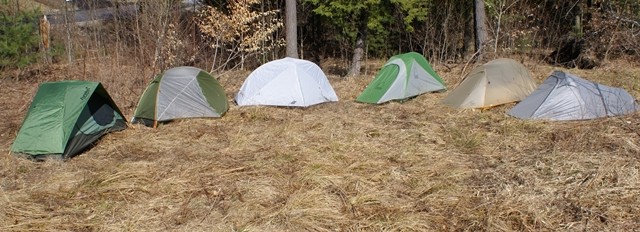
Just want to comment on the Fly Creek. Used one for a week on CDT. Light-yes. Compact-yes. Floor space-okay. Head room-inadequate. The big fat fly in the ointment is that, if it has or is raining, every time you open the vestibule flap, water drops down INTO the tent through the door and gets your bag, and anything else in the way, wet. I found this exceedingly annoying and returned the tent. The slope of the door is the problem. Big Agnes needs to fix it. Also needs to be 3 inches taller. THEN it will be worth buying.
Bets, thanks for your input! You make a good point about the water issue; the bad news is that it’s a factor for every front-entry tent we’ve tried. We’re so used to it, in fact, that we forgot to put it into the article (and we’ll be making that modification for future readers, thanks to your input). In order to avoid the water entry issue you describe, manufacturers would have to create a significantly larger and longer pole structure for the fly, which would add weight and bulk and also compromise the stability of the tents in wind to some extent. We’ve learned to automatically pull everything away from the front 6″ or so of the tents before we open the fly, and to close it as quickly as possible when its raining (if it’s raining hard, we often crawl out without fully opening the zipper). It’s definitely one of the tradeoffs of front-entry vs. side entry…but it’s by no means limited to the Big Agnes, as both the Sierra Designs and the L.L. Bean have the same characteristic.
The height issue is definitely a personal taste thing. More height = more weight, pure and simple. Big Agnes was shooting for the lowest weight, so they went with that tradeoff. It doesn’t bother us all that much when we’re trying to cut weight; the only way to go lighter is with a bivvy sack, and this is a LOT more palatable. We’ve spent a number of very happy nights in it…but then, we’re sub-6 footers. You actually might like the REI better; if you don’t mind a narrower space, you’ll get a light tent with a lot more headroom AND no water issue! Let us know what works out for you…feedback is always useful.
REI has modified the Qtr Dome T1 for 2012. The floor width opens up as you approach the head end, [39″ at head, 24″ at foot, 94″ long;] giving it a trapezoidal shape.
One weird thing is that they call it “semi” free standing which to me is means non free standing. Not sure why they are inviting a seemingly new term.
Testing it on the AT in Connecticut soon.
Tom, sorry about the delay in replying…but, our sample of the T1 hadn’t arrived. It has now, and it’s a DRAMATIC change from the old one. “Semi-freestanding” refers to the fact that it has an unusual pole structure that has two ground contact points at the head, one at the foot. So, if you don’t stake it out, the foot area collapses around your sleeping bag (in some ways similar to the Big Agnes Fly Creek UL1 that we tested). It’s not a big deal…and, when it’s staked out, the T1 is a HUGE tent compared to the previous version. We have to do a lot more testing, but based on a quick look, you’ve got yourself a winner!
I own the Eureka solo tent reviewed above. I used it recently for eight days as I bicycled across windy northwestern Kansas. High winds, including 60 mph winds during a 4 inch thunder storm, didn’t defeat it. Although a few rain drops made it between the the tent and the fly I remained dry and the tent remained erect, although I was forewarned and secured the tent with extra guy lines. The tent is heavier that the other tents reviewed, but it’s not as claustrophobic as I believe the other tents might be and it’s relatively easy to enter from the side. My recommendation for improvements would include a larger fly hang down over the longer sides and an additional zippered entry opposite of the current entry.
Jackson,
Last fall, we had the Eureka set up but unoccupied during a freak storm that dumped 28 inches of snow overnight. The Eureka was partially collapsed but otherwise undamaged–it popped right back up when we shoveled the snow off it.
We wholeheartedly agree with your over all assessment, especially the need for more fly length, but don’t see any need for two doors in a solo tent. We feel that would add extra weight and cost for little practical benefit.
I’m late to the party but found this an excellent story. You didn’t include the Kelty Gunnison (what, you didn’t test every tent in the world!) but it’s similar to the Eureka. What it has that I would note is similar weight specs (listed as 3 lb 14 oz) but a little less screen, which I prefer for cooler weather.
Dale, thanks for the comment! We actually have the Gunnison Pro 2.1 in house right now for a 2-person tent roundup that we’re working on…keep your eyes open for that one later this year. Kelty’s a long-time favorite of ours, and we’re looking forward to seeing how the new product stands up to our memories!
Thank you guys for doing this great work. You know by any chance about solo tents that come in blue? Because this is the color I sleep most comfortably in. I want to find a durable lightweight solo tent, side entry and in blue. I would be so happy if this exists.
Greetings,
Leo from Netherlands
Leo, that’s a GREAT question! We’ve seen research that shows that blue is a great bedroom color, and my own bedroom is blue. We don’t know the answer…off the top of our heads, we can’t think of any. If we do find any, we’ll let you know, and we’ll pass that on to manufacturers!